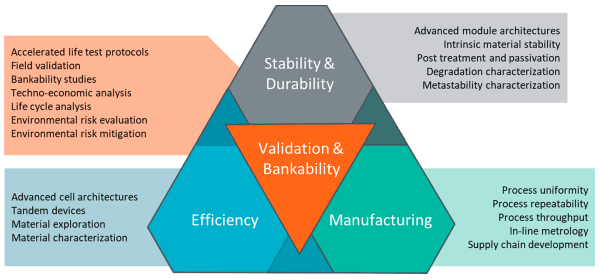If you just tuned in…
Off Grid Ham has been reporting on the progress (or lack of) perovskite solar developments for many years now. As this OGH article from November 2024 explains, research-to-market can sometimes take decades. This may seem intolerably slow, but it aligns with the development of other technologies.
To fill in those who just joined us, perovskite solar is an emerging solar panel technology based on perovskite crystals. This emerging technology is more efficient than conventional silicon solar, and can be “printed” on any surface. Unfortunately, there are technical challenges for researchers to resolve before radio amateurs will be able to buy perovskite solar.
The deal breaker.
The biggest challenge is the instability of the perovskite crystal structures themselves. They are physically fragile and break down quickly when exposed to heat or moisture, sometimes in as little as thirty days. Also, at this time perovskite crystal material must be made in tightly controlled environmental conditions, which is a difficult requirement to meet on an industrial manufacturing scale.
Obviously, this is a deal breaker. Unless and until perovskite crystals are robust enough that they have a service life competitive with silicon, and can be manufactured outside of a lab, they will not be a practical power source. This is in addition to the problem of what to do about their high lead content.
That was then, this is now.
Scientists at the Federal University of ABC in Sao Paulo, Brazil have some good news to report. They’ve developed a method using formamidinium cations (abbreviation FA+), which are positively-charged ions derived from formamidinium iodide. When researchers added FA+ to the perovskite structure, it became more stable and can better withstand adverse environments. Additionally, FA+ eliminates the requirement that perovskite be made in lab conditions.
Scientists knew about the benefits of adding FA+ to perovskite since at least 2020, but it was only recently that the Brazilians made a working, proof-of-concept prototype. The test cells still had most of their capacity after ninety days, compared to cells without the FA+ enhancement which were completely degraded after only thirty days. p

Diagram of technical challenges regarding perovskite solar commercial/retail implementation. GRAPHIC COURTESY OF ACS ENERGY LETT.
erovskite solar developments
What does this mean?
Stabilizing the perovskite crystal structure is a huge leap forward towards getting this technology out to the consumer market. As we’ve discussed before here on Off Grid Ham, it is not unusual for it to take decades between an initial discovery and a commercially available product. Still, this development is significant.
There are some caveats. First, scientists do not know how long FA+ enhanced perovskite will last in long term, real world conditions. The tests clearly prove that they are more robust than un-enhanced cells, but can they run for 20, 25, or more years as silicon does now? That part of the research is ongoing. perovskite solar developments
Second, scientists claim the process of adding FA+ is easy and scalable to an industrial level. At this point that’s just a theory because it hasn’t actually been done yet. While we can be very confident that the Brazilians know what they are talking about, the theory will be become fact only when products start rolling out of the factories.
And speaking of factories, none exist yet. Business people and process engineers, not scientists, are best qualified to figure out how to turn a lab prototype into a mass-produced product. That is an entirely different topic we’ll address when the time comes.
The future is…not yet. perovskite solar developments
As encouraging as this development is, it’s still going to be a while before we can jump on Amazon and have a perovskite solar panel delivered the next day. Numerous clickbait ads on line falsely claim they are available now. When I asked an artificial intelligence bot when perovskite will be available, it said they could be on the market in 2025. Yeah, right. An actual human capable of critical thinking (myself) looked into the question and determined that 2028-2030 is a more realistic time window.
What we have to remember is that perovskite solar is still in the research stage. What the Brazilian scientists are doing is a big advance and we owe them gratitude for that, but we should not overanalyze it. When perovskite solar appears on store shelves it will be worth the wait.
Off Grid Ham is the only known internet media source covering perovskite solar developments from a ham radio perspective. I will post follow up articles about this topic as needed. Subscribe for email notifications so you will not miss anything!